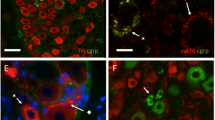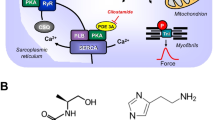Abstract
We have characterized the contractile responses produced by stimulation of the tachykinin NK2 receptor in the hamster urinary bladder in vitro and in vivo. In isolated bladder strips, neurokinin A (NKA, pD 2 7.40, Emax 71% of the response to 80 mM KCl) and the synthetic tachykinin NK2 receptor selective agonist [βAla8]NKA(4–10) (pD 2 7.48, Emax 77% of the response to KCl) both induced a concentration-dependent contraction, whereas the tachykinin NK1 and NK3 receptor selective agonists, [Sar9]substance P sulfone and senktide, respectively, produced a negligible contractile effect. The bicyclic peptide antagonists MEN 11420 and MEN 10627 behaved as competitive antagonists of the response to [βAla8]NKA(4–10) with apparent pK B values of 9.3 and 9.7, respectively. Comparable apparent pK B values were estimated against NKA (pK B 9.2 and 9.4 for MEN 11420 and MEN 10627, respectively). Under isovolumetric recording of the intravesical pressure, the nicotinic receptor agonist DMPP (0.6 µmol/kg i.v.) produced a phasic contraction of the hamster bladder in vivo that was abolished by hexamethonium (110 µmol/kg i.v.) or by surgical ablation of pelvic ganglia. In vivo [βAla8]NKA(4–10) (10 nmol/kg i.v.) induced a tonic-type sustained bladder contraction with superimposed high frequency and small amplitude (<12 mmHg) phasic contractions and, in about 70% of cases examined, a few high amplitude (>20 mmHg) phasic contractions. Hexamethonium abolished the high amplitude phasic contractions, indicating their reflex origin. In animals subjected to the ablation of pelvic ganglia, the urinary bladder response to [βAla8]NKA(4–10) was comparable to that observed after administration of hexamethonium. Moreover, hexamethonium did not affect the contractile responses to [βAla8]NKA(4–10) in ganglionectomized animals. MEN 10627 and MEN 11420 produced a dose-dependent and long-lasting inhibition of the contractile response to [βAla8]NKA(4–10): the least effective doses of the two antagonists were 30 and 3 nmol/kg i.v. for MEN 10627 and MEN 11420, respectively. An almost complete and long-lasting inhibition of the response to the agonist was produced at doses of 10 and 100 nmol/kg i.v. of MEN 11420 and MEN 10627. In urethane-anaesthetized hamsters the non-stop intravesical infusion of saline (50 µl/min) produced repetitive micturition cycles which were abolished by hexamethonium (110 µmol/kg i.v.) or by surgical removal of the pelvic ganglia. MEN 11420 (100 nmol/kg) had no significant effect on the volume-evoked micturition reflex in anaesthetized hamsters. In conclusion, the hamster urinary bladder is a suitable preparation for studying the action of tachykinin NK2 receptor antagonists in vivo: in this species, the stimulation of tachykinin NK2 receptors induces bladder contractions. Blockade of tachykinin NK2 receptors does not appreciably modify the volume-evoked micturition reflex in this species.
Similar content being viewed by others
Author information
Authors and Affiliations
Additional information
Received: 22 April 1998 / Accepted: 12 June 1998
Rights and permissions
About this article
Cite this article
Tramontana, M., Patacchini, R., Lecci, A. et al. Tachykinin NK2 receptors in the hamster urinary bladder: in vitro and in vivo characterization. Naunyn-Schmiedeberg's Arch Pharmacol 358, 293–300 (1998). https://doi.org/10.1007/PL00005256
Issue Date:
DOI: https://doi.org/10.1007/PL00005256




